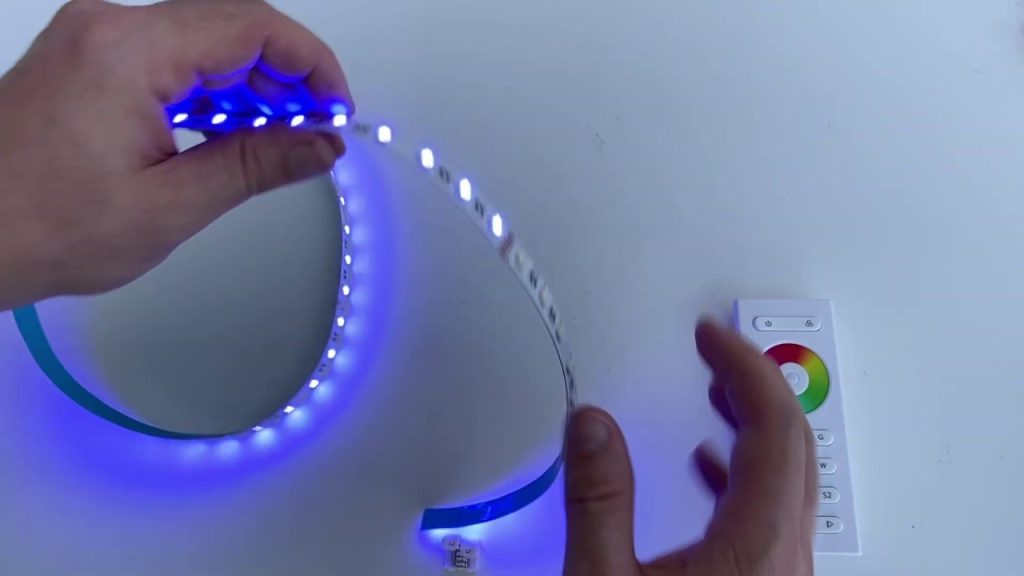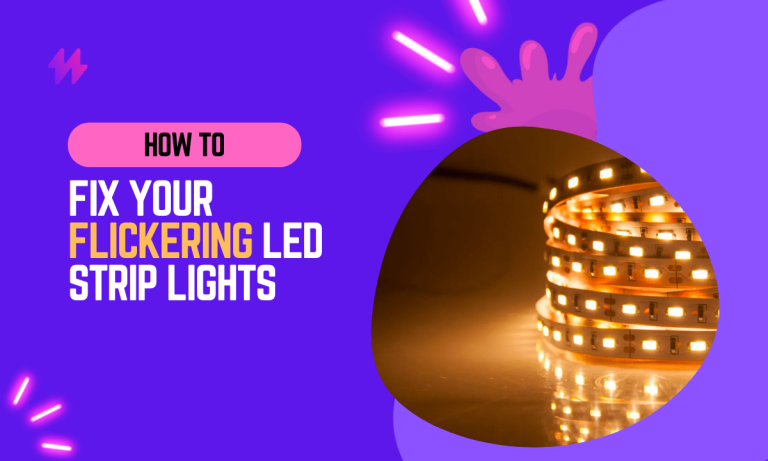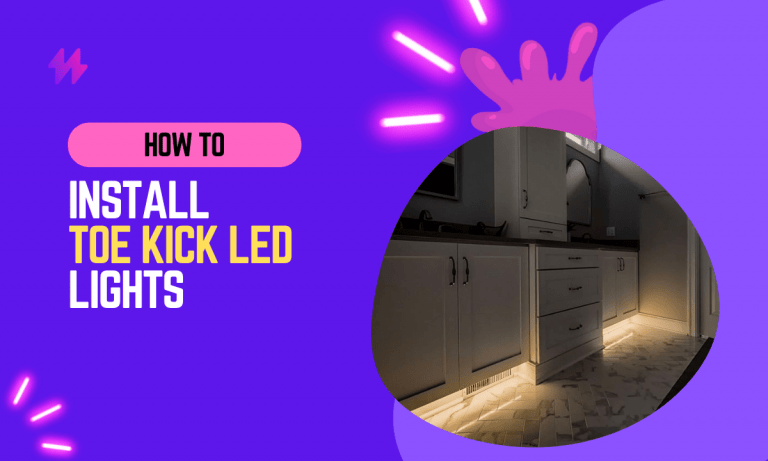How To Fix LED Light Remote Wrong Colors

LED lights have become increasingly popular due to their energy efficiency, long lifespan, and vibrant lighting effects. Along with these lights, remote controls have become an everyday accessory, allowing users to conveniently control various aspects of their LED lighting setup.
However, it is not uncommon to encounter issues with LED light remotes, such as the display showing the wrong colors. If you’re facing this problem, don’t worry – we’ve got you covered.
In this blog post, we will provide a step-by-step guide on how to fix LED light remote wrong colors display.
If you’ve recently installed LED light systems and notice that the colors emitted are inconsistent, this could signify a faulty remote control or issues in the setup. It’s essential to troubleshoot both the RGB controller and the connection to your light strips to ensure that your next lighting project showcases the right colors as intended.
Understanding Why Your LED Light Remote Is Not Displaying the Correct Color

There can be several reasons behind this issue, and understanding them can help you troubleshoot and resolve the problem effectively. Here are some common factors that may cause your LED light remote to display incorrect colors:
When troubleshooting your RGB LEDs, you may want to inspect the power draw to ensure it meets the voltage requirements for your light strips without causing any voltage drop. Additionally, consider testing the settings on your lighting node to assess any color inconsistencies that could arise from faulty wiring or a malfunctioning controller.
Battery Issues: Understanding How to Resolve LED Light Remote Color Problems
A depleted or low-quality battery can affect the performance of your LED light remote. If the battery power is insufficient, it may not transmit the correct signals to the LED lights, resulting in the wrong colors being displayed. Ensure that you have fresh batteries installed in the remote and check if that resolves the issue.
A proper functioning remote is crucial to achieving the desired color output from your light emitting diode systems. When dealing with various colors in your outdoor lights, consider that a faulty controller might cause inconsistent color output, disrupting the vibrant blue LED lighting design you aimed for.
Optimizing Remote and Receiver Alignment for Correct LED Light Colors
LED light remotes communicate with the lights through a receiver unit. If the remote and receiver are not properly aligned, the signals may not be transmitted accurately. Objects obstructing the line of sight between the remote and the receiver can also interfere with the signal. Make sure there are no physical obstructions and that the remote is pointing toward the receiver for optimal communication.
To maximize the efficiency of your LED lighting setup, be mindful of the potential for light strips damage which might occur due to obstructed signals or faulty connections. By ensuring the correct color settings, you can achieve a striking light design that showcases an array of colored outputs, including blue light and dynamic color variations, enhancing the overall ambiance of your space.
Addressing Incorrect Remote Control Settings: Troubleshooting LED Light Color Issues
LED lights often come with different color modes, brightness levels, and effects. If the remote control settings are not configured correctly or accidentally changed, it can lead to incorrect color outputs. To resolve this, it is important to learn how to reset the LED light remote controller and ensure that the settings match the desired color mode or effect you wish to achieve.
Properly configuring your LED light remote controller is vital for achieving the intended static color and prevents color output issues that can arise from incorrect settings. It’s always beneficial to consult your LED strip manufacturer’s guidelines for troubleshooting approaches to effectively manage inconsistencies in the light colors, including vibrant tones like coral color or cool shades such as cyan color.
Understanding Signal Interference in LED Light Remotes: Causes and Solutions
Other electronic devices operating on similar frequencies as the LED light remote can interfere with the signals. Wi-Fi routers, cordless phones, or even nearby electronics can disrupt the communication between the remote and the LED lights. Keep these devices away from the LED lights and remote, and ensure they are not causing any interference.
To enhance the performance of your LED lighting system, consider adjusting the signal reception by relocating any potentially interfering devices. This can help prevent led failure and ensure that your individual LEDs deliver the vibrant hues you desire, including full brightness in your preferred primary color or neutral colors.
Addressing Firmware or Software Issues With Your LED Light Remote
In some cases, the LED light remote or the receiver unit may require a firmware or software update to address bugs or compatibility issues. Check the manufacturer’s website or user manual for any available updates and follow the instructions to update the firmware.
Also read: Why do LED Light Flicker on Video and Camera?
To achieve the best results with your LED light colors, remember that keeping firmware or software updated is vital for optimal performance. This ensures that your setup can handle different remote controllers and maintain the expected vibrant colors across various segments of your LED strips.
How To Fix Wrong LED Light Remote Colors: A Comprehensive Guide

If your LED light remote is displaying the wrong colors, there are several steps you can take to troubleshoot and resolve the issue. Follow these guidelines to fix your LED light remote and restore the accurate color display.
When troubleshooting your LED light remote, it’s important to check if your setup can produce different color outputs effectively, ensuring that all LED strip segments are functioning properly. If you notice any dead LEDs or the white brightness appears inconsistent, it may indicate an issue with the power supply or a fault in the LED strips function that needs resolution.
How to Fix LED Light Remote Wrong Colors: Check the Battery
The first step is ensuring the remote’s battery is not low or depleted. Replace the battery with a fresh one and check if this resolves the problem. Make sure to use the correct battery type as specified by the manufacturer.
To enhance your LED setup and avoid potential issues, it’s crucial to regularly inspect the functionality of your remote control and connections. By ensuring that your lights are properly set, you can enjoy a vibrant array of colors, including pure white and dynamic different color tones that reflect your design vision, while avoiding any possible overheating of the LEDs.
Aligning the Remote and Receiver: Troubleshooting Your LED Light Remote Issues
Proper alignment between the LED light remote and the receiver is crucial for effective communication. Remove any obstructions and ensure that the remote is pointed directly toward the receiver unit. This helps ensure that the signals are transmitted accurately.
Achieving the desired colors from your LED lights can significantly enhance your space’s ambiance. If you notice any issues where the color dies or white LEDs seem off, consider checking the remote settings and the alignment with the receiver to ensure a smooth operation.
Resetting the Remote and Lights: Effective Solutions for LED Color Issues
Resetting the LED lights and the remote control can often resolve color display issues. Turn off the LED lights using the remote control, unplug the power source from the lights, wait for a few seconds, and then plug it back in. Turn on the lights using the remote and check if the colors are now displayed correctly.
When you reset the LED lights and remote, this can help restore their ability to display several colors accurately. You can visit hitlights.com for more information on achieving optimal color output, including using pre-set color patterns to enhance your lighting design while ensuring your LEDs do not overheat.
Ensure Correct Remote Control Settings for LED Light Colors
Check the settings on both the LED light remote and the lights themselves. Ensure that the color mode, brightness level, and any other settings are properly configured. Compare the settings on the remote with the desired color output you want to achieve.
To achieve a vibrant display of colors with your LEDs, it is crucial to verify that all configurations match your intended visual effects. Regular inspections can help prevent situations where LEDs overheat or fail to produce the desired white color, ensuring a seamless LED link for your overall lighting setup.
Ensure Proper Communication: Troubleshooting Your LED Light Remote for Color Issues
Make sure that there are no other electronic devices or appliances nearby that might interfere with the remote’s signal. Keep the LED lights and the remote away from Wi-Fi routers, cordless phones, and other devices that can operate on similar frequencies. Additionally, stay within the recommended range mentioned by the manufacturer for optimal communication.
Incorporating the right setup for your LED lights will allow you to enjoy a spectrum of vibrant colors without interference from other devices. By managing your environment and ensuring your LEDs are configured correctly, you’ll experience the full potential of your lighting system, showcasing beautiful colors that elevate any setting.
Current Firmware Update: Essential Steps for Optimal LED Light Performance
Check the LED light manufacturer’s website or user manual to see if there are any available firmware updates for your LED lights or the remote control. Updating the firmware can address any software bugs or compatibility issues that might be causing incorrect color displays.
Keeping your LED lights updated not only enhances their longevity but also improves the accuracy of the colors they display. Regular firmware updates are essential for ensuring that your LEDs remain compatible with various remote controls, allowing you to enjoy a rich palette of colors.
Contact the Manufacturer for Assistance with LED Light Remote Color Issues
If you have tried the above steps and the problem persists, it is recommended to reach out to the manufacturer’s customer support. They can provide specific troubleshooting advice or recommend further actions to resolve the issue. Provide them with detailed information about the problem and any steps you have already taken.
When seeking assistance from the manufacturer, be sure to mention any specific colors or patterns of your LEDs that are malfunctioning. This detailed communication can lead to a more efficient resolution, ensuring your LED system can showcase the vibrant colors as originally intended.
Seek Professional Help: Resolving LED Light Remote Color Issues
If all else fails, consider consulting a professional technician or an electrician who specializes in LED lighting systems. They have the expertise to diagnose and fix complex issues with LED lights and remotes.
By following these steps and troubleshooting methods, you can identify and resolve the issue with your LED light remote displaying the wrong colors. Remember to always refer to the manufacturer’s instructions and guidelines specific to your LED light model for the best results.
When dealing with malfunctioning LEDs, seeking professional help can provide insights beyond basic troubleshooting. Their expertise can ensure that your systems effectively display the desired colors, enhancing the overall effectiveness of your LED setups.
How to Fix LED Light Remote Issues: Correcting Mixed-Up Colors

If your LED lights are displaying mixed-up colors, where different colors are not aligning correctly or appearing in the wrong places, it can be frustrating. However, there are several steps you can take to troubleshoot and fix this issue.
One effective method to address mixed-up colors in your LED lighting system is to carefully check the connections between the controller and the LEDs to ensure they are secure and properly aligned. Additionally, adjusting the settings on your controller can help restore the correct colors to your LEDs, leading to a visually pleasing display in your space.
Verify Your LED Light Connections for Correct Color Output
Ensure that all the LED light connections are secure and properly seated. Loose connections can cause mixed-up colors or erratic behavior. Turn off the LED lights and examine the connections between the power supply, controller, and the LED light strips or bulbs. Reconnect them securely if necessary.
Regularly examining your LED light connections is vital to maintaining the vibrant colors you desire. By ensuring all components are securely attached, you can significantly reduce issues that might affect the performance of your LEDs.
Ensure Correct Wiring for Optimal LED Light Functionality
Confirm that the wiring is correct and matches the manufacturer’s instructions. Incorrect wiring can lead to mixed-up colors. Check the positive (+) and negative (-) connections between the power supply, controller, and LED lights. Make sure the wiring is properly aligned and securely connected.
It’s important to keep a close eye on any discrepancies in colors emitted by your LEDs, as incorrect connections may lead to unexpected results. Properly verifying that your LEDs are wired according to the manufacturer’s specifications can help maintain the vibrant colors you desire.
Resetting LED Lights for Correct Color Functionality
Resetting the LED lights can often resolve color mixing issues. Turn off the lights using the remote or power switch, unplug the power source, and wait for a few seconds. Plug the power source back in and turn on the lights. This helps refresh the system and may fix any temporary glitches causing color mixing.
To achieve vibrant and consistent colors from your LEDs, proper maintenance and occasional resets can make a significant difference. If you experience ongoing issues with the colors displayed, consider revisiting your setup and connections to enhance your LED lighting experience.
Adjusting RGB Channels: Troubleshooting LED Light Color Issues
If you have RGB LED lights (Red, Green, Blue), there might be an issue with the individual color channels. Many LED light controllers allow you to adjust the intensity of each color independently. Use the remote control or controller interface to increase or decrease the intensity of the RGB channels until the colors align correctly.
To achieve accurate colors from your RGB LEDs, make sure to utilize the remote effectively by fine-tuning each channel until the desired hues are reached. Monitoring and adjusting the settings can greatly enhance the visual experience, ensuring your LEDs display a harmonious blend of colors.
Calibrate LED Light Remote Color Control: Essential Tips and Fixes
Some LED lights or controllers offer color calibration options. This feature allows you to fine-tune the color output to ensure accuracy. Refer to the user manual or manufacturer’s instructions to access the color calibration settings. Follow the provided steps to calibrate the colors and align them correctly.
It’s essential to regularly check and adjust your LED color settings to ensure that the output remains consistent and true to your intent. By utilizing the color calibration options available in your LED system, you can maintain vibrant colors that enhance your overall lighting experience.
Concluding Thoughts on Fixing LED Light Remote Color Issues
In conclusion, fixing an LED light remote that is displaying incorrect colors often involves a blend of troubleshooting steps that can restore proper functionality without the need for professional help. Initially, ensuring that the remote’s battery is fresh and properly installed can resolve many issues related to weak signal strength or erratic behavior. If battery replacement does not solve the problem, resetting the remote or the LED light system can often recalibrate the color settings. This process typically involves either using a reset button on the device or unplugging the power supply for a set period before reconnecting it. Such resets help to clear any glitches in the system’s memory that might be causing the color discrepancies.
Furthermore, if these steps do not correct the color issues, it may be necessary to check the LED controller and connections for any signs of damage or loose wires, which can interfere with the color output. Ensuring all connections are secure and the controller is functioning correctly can often resolve problems related to color misalignment. In instances where DIY fixes do not rectify the issue, consulting the manufacturer’s support resources or seeking advice from a professional may be advisable. This approach not only helps in resolving the specific problem but also aids in understanding the product better, potentially preventing future issues. By methodically following these troubleshooting steps, users can effectively manage and maintain their LED lighting setups, ensuring vibrant and accurate colors that enhance the ambiance of any space.






